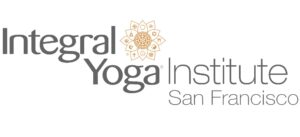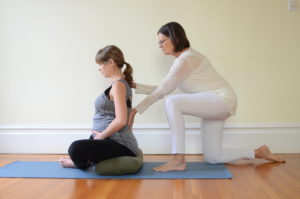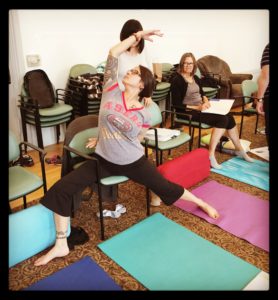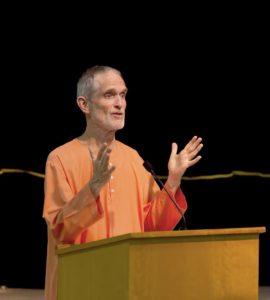What happens in an Integral Yoga Prenatal Class
By Sarani Beth Fedman
The prenatal class at the San Francisco Integral Yoga Institute has been held on a weekly basis for over five years. It meets Wednesday evenings from 6:00-7:30. Many of you are not pregnant or have never taken a prenatal class, but you may have walked past the classroom on Wednesday evenings and seen the pregnant mamas arriving or departing. You may have seen us listed on the schedule or on the website, and perhaps you would enjoy knowing more about the class and how it works.
Gentle Poses and Breath as a Foundation: We usually begin class with a check-in to see how everyone is doing and if there are any issues or areas that need to be addressed. In general we use a gentle approach to strengthening and toning the physical body. We work on strengthening the core (it is doing extra duty with the changing body), the lower back (it is also having to make constant adjustments to the weight it is supporting), and the upper body (in preparation for lifting, carrying and holding the new being that will soon arrive). Gentle warm ups and asana are offered. Everyone is encouraged to find their own expression of each pose and own it! Asanas are presented as tools to use in everyday life, as a way to address extended time at a desk, and to offset our more sedentary lifestyle. Yoga is also a wonderful way to appreciate and savor the miraculous changes of the pregnant body.
As in regular yoga classes, breath is key. We attend to the breath through the entire class. We especially work with a breathing technique that can be used during labor and delivery. The breath’s restorative, calming, and focusing effects are all explored.
Posture is also emphasized. Something as simple as coming into Mountain Pose (easeful, stable standing posture) with adjustments to the changing form of the pregnant body can be a great relief and support. Balancing poses are especially beneficial to help the pregnant student navigate her day with ease and grace.
Taking asana poses and techniques learned in class into daily life is always supported. Specific suggestions are made in each class about how to use yoga tools to address such issues as tiredness, nausea, edema, insomnia or other common discomforts of pregnancy. We explore techniques such as massage, acupressure, and visualizations throughout the class as a way of addressing physical discomfort and as tools to use in daily life and in labor and delivery.
Emotional and Spiritual Connection: The emotional and spiritual needs of pregnant women are explored and supported through the sharing of thoughts and information. A Deep Relaxation with a Body Scan is offered in the last half hour of class. Hormones released in abundance during pregnancy can lead to emotional ups and downs. Relaxation techniques, breathing practices, poses, and meditation can all help the body and brain to release stress and anxiety. The pregnant mama can find calm and move into a more easeful attitude towards her changing landscape. Sharing the class with other women who are having similar experiences can be reassuring and helps form bonds of friendship and community. We often work with partners in class and encourage sharing of experiences and resources, and bonding through open discussions at the beginning and end of class to develop community and friendships.
We also explore meditation towards the end of each class. A variety of guided meditations are offered. Body, mind, and spirit are invited to connect with self, baby, loved ones, all beings, and the universal.
Invite a Friend to Join Us: Of course we are always looking for new students because each student “graduates” when she gives birth. Please consider letting any newly pregnant moms in your group of friends, family and acquaintances know about our classes. You can send them a link to this blog article to give them a clear picture about what the class looks like and our approach. Invite them to come benefit from the many ways yoga can be of support during their pregnancy. It is an amazing experience that comes through sharing and savoring this time of life with community.
A separate Labor and Delivery Workshop is offered every 4-6 months, depending on the due dates of the students. In it we explore yoga poses, breathing techniques, massage and acupressure, and relaxation and visualization tools that can be used during labor and delivery. Partners are invited to participate and their supporting role is explored.
Sarani Beth Fedman has studied, practiced and taught yoga for over 20 years. Most of her teacher training was completed at Yogaville, Virginia, the home of Satchidananda Ashram. These teacher trainings through Integral Yoga include Basic and Intermediate Hatha, Prenatal and Postnatal, Meditation, Raja (Philosophy), Children’s and Special Needs Yoga, Restorative, Reducing Anxiety, Accessible and Therapeutic Yoga. She has also studied Mindfulness Yoga with Frank Jude Boccio and Buddhist Meditation with Thich Nhat Hanh, Sharon Salzberg, and Joseph Goldstein. Her approach is inclusive and adaptive with the understanding that everyone can benefit from the practices and teachings of the ancient wisdom of yoga. Each of her therapeutic students receives support through an individualized practice plan with the goal to reduce stress and discomfort and promote healing and a deep sense of well being. She has received her yoga teacher certification from Yoga Alliance at the RYT500 level and is a certified yoga therapist through the International Association of Yoga Therapists.






